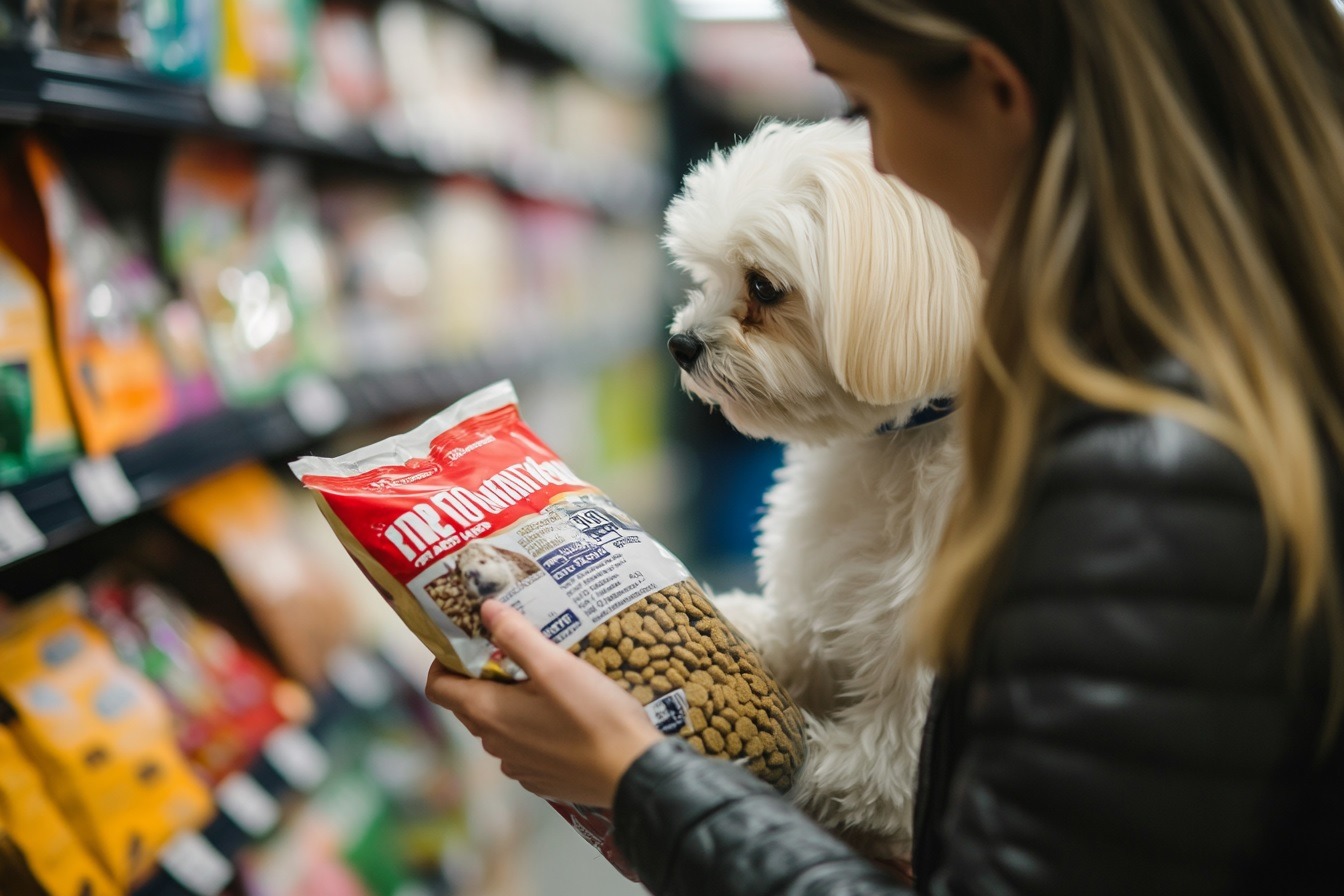
Decoding Pet Food Labels: What Those Ingredients Really Mean.
Pet food labels can be confusing, filled with complex terms, hidden additives, and marketing claims that don’t always reflect nutritional quality. Understanding what those ingredients truly mean is essential for your pet’s health. This guide explains how to read labels, identify high-quality ingredients, and make informed decisions to ensure your furry companion receives a balanced, safe, and wholesome diet.
🐶 Pet Star
59 min read · 16, Oct 2025

Introduction
If you’ve ever stood in the pet food aisle trying to choose between “natural,” “premium,” or “grain-free” options, you’re not alone. Modern pet food packaging is filled with buzzwords designed to attract pet parents who only want the best for their companions. Yet, behind those glossy bags and appetizing pictures lies a complex system of regulations, marketing tactics, and ingredient hierarchies that often leave consumers more confused than informed.
Understanding pet food labels isn’t just about recognizing ingredients—it’s about decoding what they truly mean. Terms like “meat by-products,” “animal meal,” “crude protein,” or “AAFCO approved” can significantly impact the nutritional quality of your pet’s food. Moreover, manufacturers often use clever labeling techniques to make products appear healthier or more natural than they really are.
This article will guide you through the essential aspects of reading and interpreting pet food labels. You’ll learn how to identify quality ingredients, spot red flags, understand nutrient breakdowns, and see through marketing gimmicks. Whether you’re feeding a loyal dog or a finicky cat, this knowledge empowers you to choose the right diet for your pet’s needs—based on facts, not flashy claims.
Understanding the Pet Food Label
1. The Importance of Pet Food Labels
Pet food labels serve two purposes: regulatory compliance and consumer information. Every commercial pet food must meet certain labeling standards set by authorities like the Association of American Feed Control Officials (AAFCO) in the U.S. or the FSSAI in India. These standards ensure that pet foods are safe, properly identified, and nutritionally adequate.
However, labels are also marketing tools. They’re crafted to appeal to emotions—using words like “holistic,” “human-grade,” or “veterinarian-approved”—even if these terms don’t always have a regulated meaning. Hence, decoding what’s factual versus what’s promotional is key to making the best decision for your pet.
2. Reading the Ingredient List
Just like human food, pet food ingredients are listed in descending order by weight. The first few ingredients make up the majority of the product, so always look at the top five.
a. Meat and Meat Meals:
If the first ingredient is “chicken,” “beef,” or “salmon,” that’s a good sign. Fresh meats contain moisture, though—so a “chicken meal” (which is dried, concentrated protein) might actually provide more protein per gram.
- Example: “Chicken meal” is more nutrient-dense than “chicken” listed alone.
- Beware: Terms like “meat by-products” or “animal digest” often indicate lower-quality leftovers like organs, fat, or bones. While not inherently harmful, they’re less desirable than whole meats.
b. Grains and Fillers:
Corn, wheat, and soy are common fillers. They provide carbohydrates but limited nutritional value. Some pets tolerate them well, while others (especially with allergies) may react negatively. Grain-free formulas substitute these with peas, lentils, or potatoes—but these, too, should be in moderation.
c. Fats and Oils:
Healthy fats like chicken fat, fish oil, or flaxseed oil supply essential fatty acids that promote skin and coat health. Avoid ambiguous sources like “animal fat (preserved with BHA/BHT),” as these artificial preservatives can be harmful over time.
d. Vegetables and Fruits:
When you see “carrots,” “sweet potatoes,” or “blueberries,” they often add fiber, vitamins, and antioxidants. However, these ingredients are often in small quantities—so don’t be misled into thinking the food is as healthy as a fresh produce salad.
3. Guaranteed Analysis: What Those Numbers Mean
Every pet food label must include a Guaranteed Analysis section, listing the minimum percentages of protein and fat and the maximum percentages of fiber and moisture.
For example:
- Crude Protein (min): 28%
- Crude Fat (min): 15%
- Crude Fiber (max): 5%
- Moisture (max): 10%
“Crude” doesn’t mean rough or unrefined—it’s simply a chemical term referring to how nutrients are measured. However, comparing dry and wet foods requires adjusting for moisture content. Wet food naturally contains more water, so the nutrient density per gram differs significantly.
To compare, you can use the Dry Matter Basis formula:
(Nutrient % ÷ (100 – Moisture %)) × 100
This helps you see the true nutrient content of different foods.
4. Decoding Common Terms
Pet food manufacturers often use attractive words—but not all are regulated. Here’s what they actually mean:
- Natural: Contains no artificial colors, flavors, or preservatives—but processing may still occur.
- Organic: Certified by official agencies; ingredients grown without synthetic fertilizers or pesticides.
- Holistic: Marketing term; no legal definition.
- Human-Grade: Must be made from ingredients fit for human consumption, but not all “human-grade” foods meet this strict standard.
- Grain-Free: Contains no corn, wheat, or rice—but may use other carbohydrate sources.
- Limited Ingredient Diet (LID): Designed for pets with allergies or sensitivities; fewer components make it easier to identify triggers.
5. AAFCO Statement: Nutritional Adequacy
This small line on the label reveals whether the food is “complete and balanced.” AAFCO-approved diets meet the nutrient profiles necessary for a specific life stage (e.g., “for adult maintenance,” “for all life stages,” or “for growth”).
Always look for:
“This product is formulated to meet the nutritional levels established by the AAFCO Dog Food Nutrient Profiles.”
If this statement is missing, the product might be a treat or supplement—not a primary diet.
6. Hidden Ingredients and Additives
Many pet foods contain synthetic additives for flavor, color, or preservation. Some are harmless; others are controversial.
- Artificial Colors: Red 40, Yellow 5 – unnecessary and potentially allergenic.
- Preservatives: BHA, BHT, Ethoxyquin – may be linked to long-term health risks.
- Flavor Enhancers: Animal digest – vague and low-quality source.
Instead, look for natural alternatives like mixed tocopherols (vitamin E) or rosemary extract.
7. “Splitting” Ingredients—A Label Trick
Manufacturers often split ingredients to push less desirable ones lower in the list.
For example, instead of listing “corn” as the first ingredient, they may list “corn flour,” “corn meal,” and “corn gluten.” Each weighs less individually, but together they might outnumber the meat content. Always consider ingredient groups collectively.
8. Special Diets and Formulas
Labels may highlight diets tailored for specific needs—such as “weight control,” “sensitive stomach,” or “dental health.” While some are genuinely beneficial, many rely on minor formulation tweaks and clever marketing. Always check nutrient content and consult a veterinarian before switching diets.
9. Reading the Fine Print
Beyond the flashy design, examine:
- Manufacturing Information: “Made by” means the company produced it; “distributed by” may indicate third-party manufacturing.
- Best Before Date: Ensures freshness, especially for fat-containing foods.
- Feeding Guidelines: Useful, but only a starting point—your pet’s age, activity level, and health will influence actual needs.
Understanding pet food labels is more than just glancing at flashy packaging or trusting marketing claims; it requires a meticulous approach to dissecting every element listed on the bag or can to ensure that the food you choose provides your pet with optimal nutrition, supports long-term health, and avoids harmful or unnecessary additives. First and foremost, the ingredient list is a critical starting point because it reveals what constitutes the majority of the product, with ingredients listed in descending order by weight. Quality pet food should feature a named animal protein—such as chicken, beef, lamb, or salmon—as the first ingredient, which ensures that your pet is receiving a diet rich in high-quality protein essential for muscle development, energy, and overall vitality. Protein sources are often listed in multiple forms, including fresh meat, meat meals, or meat by-products, and understanding the distinction between these terms is vital; for example, “chicken meal” is a concentrated source of protein with much of the moisture removed, making it more nutrient-dense than fresh chicken, whereas meat by-products can vary widely in quality, potentially including organs, bones, and other parts less desirable than whole meat but still providing nutrients. Carbohydrates are another key consideration, with common fillers like corn, wheat, and soy providing energy but limited additional nutrition; while some pets tolerate these ingredients well, others with food sensitivities or allergies may experience digestive or dermatological issues, prompting some pet parents to consider grain-free alternatives, though it is important to note that grain-free formulas substitute these carbohydrates with items like peas, lentils, or potatoes, which, while sometimes healthier, must also be carefully balanced to prevent nutrient excess or deficiency. Fats and oils, often listed as chicken fat, fish oil, or flaxseed oil, contribute essential fatty acids such as omega-3 and omega-6, which are crucial for maintaining healthy skin, a shiny coat, and proper cellular function, whereas vague descriptors like “animal fat preserved with BHA/BHT” indicate synthetic preservatives that may pose long-term health risks and should generally be avoided. Vegetables and fruits, including ingredients like carrots, sweet potatoes, and blueberries, provide vitamins, antioxidants, and fiber, yet their actual proportion in the food may be minimal, meaning they may have limited effect on the overall diet despite appearing prominently on the label for marketing purposes. Beyond the ingredient list, the Guaranteed Analysis section provides a chemical breakdown of nutrients, listing minimum percentages of crude protein and fat and maximum percentages of crude fiber and moisture; although the term “crude” does not imply low quality, it is a technical term used to describe the way nutrients are measured, and interpreting these figures requires awareness of the moisture content in wet versus dry food, as wet foods naturally contain more water and therefore appear to have lower protein or fat percentages per gram, a discrepancy corrected through calculations like the Dry Matter Basis formula, which allows for accurate comparisons of nutrient density across products. Deciphering pet food labels also involves understanding marketing terminology, much of which is not legally regulated; terms like “natural” may indicate the absence of artificial colors, flavors, or preservatives but do not guarantee minimal processing, while “organic” generally refers to certified ingredients grown without synthetic fertilizers or pesticides; “holistic” is largely a marketing term with no standardized definition, and “human-grade” can be misleading unless officially certified, as not all products labeled this way meet strict requirements. Furthermore, the AAFCO statement on the label indicates whether the food is “complete and balanced” according to nutrient profiles suitable for a particular life stage, such as maintenance for adult pets, growth for puppies and kittens, or all-life-stage formulations, making this line one of the most critical for ensuring the diet meets minimum nutritional adequacy. Many pet foods contain hidden additives, including artificial colors like Red 40 or Yellow 5, preservatives such as BHA, BHT, or ethoxyquin, and flavor enhancers like “animal digest,” which can vary in quality and safety, whereas natural alternatives such as mixed tocopherols (vitamin E) or rosemary extract are generally safer and sufficient for shelf stability. Pet owners must also be aware of “ingredient splitting,” a technique where manufacturers divide a single ingredient, such as corn, into multiple forms like corn flour, corn meal, and corn gluten, to make it appear lower on the ingredient list despite collectively representing a significant portion of the product, potentially overshadowing protein content. Special diets and formulas marketed for weight management, sensitive stomachs, or dental health should be evaluated carefully; while some offer genuine benefits, others rely on minor modifications and marketing language rather than substantial nutritional differences. Reading the fine print, including manufacturing information, expiration dates, and feeding guidelines, is equally important, as “made by” versus “distributed by” can indicate the quality control standards of the manufacturer, and feeding guidelines serve only as starting points, with actual portions needing adjustment based on a pet’s age, activity level, and individual health. Ultimately, decoding pet food labels is an exercise in critical thinking and awareness: understanding protein sources, carbohydrate quality, fat composition, presence of fruits and vegetables, additives, preservatives, and the meaning behind marketing claims enables pet owners to choose foods that support optimal nutrition, prevent disease, and promote longevity. This comprehensive approach also encourages transparency and accountability from pet food manufacturers, empowering consumers to make informed choices and advocate for the well-being of their furry companions. By taking the time to analyze each aspect of a label, consider nutrient density, and interpret terminology correctly, pet parents can ensure they are not misled by marketing gimmicks and are instead providing a balanced, healthful diet that meets the individual needs of their pet, enhancing energy levels, immune function, digestive health, and overall quality of life, while simultaneously developing a more discerning eye for spotting low-quality ingredients, unnecessary fillers, synthetic preservatives, and misleading claims, which is particularly important in a market saturated with hundreds of options that appear visually appealing but vary widely in actual nutritional value and safety. The key to this process lies in education, vigilance, and critical evaluation, understanding that a well-informed choice today can prevent nutritional deficiencies, obesity, digestive problems, allergies, and other long-term health complications tomorrow, ultimately fostering a stronger, healthier bond between pet and owner, founded on care, responsibility, and evidence-based nutrition decisions.
Decoding pet food labels is a crucial skill for any responsible pet owner, yet it is one that is often overlooked because of the complex terminology, marketing jargon, and regulatory nuances that make labels appear more confusing than they truly are, and understanding these labels begins with the ingredient list, which is perhaps the most important part of any pet food package, as ingredients are listed in descending order by weight, meaning that the first few items constitute the majority of the food, and therefore, the first ingredient should ideally be a named animal protein, such as chicken, beef, lamb, or salmon, since these are rich sources of high-quality protein, essential amino acids, and nutrients that support muscle growth, energy, and overall health, whereas ambiguous terms like "meat by-products" or "animal digest" can vary widely in quality, sometimes including organ meat, bones, or other low-quality remnants, which are not inherently harmful but are generally considered less desirable than whole, named meats; additionally, protein ingredients can appear in various forms, including fresh meat, dehydrated meat meals, or protein concentrates, and understanding the differences is essential because a meat meal, despite sounding processed, can be a concentrated source of protein, whereas fresh meat contains water weight and may provide less actual protein per unit; beyond protein, carbohydrates play a significant role in pet nutrition, and labels often include grains such as corn, wheat, and soy, which act as fillers providing energy but limited nutritional value, and while some pets digest these ingredients well, others with allergies or sensitivities may experience digestive disturbances, skin irritation, or other health issues, prompting some pet owners to choose grain-free alternatives, although grain-free does not automatically mean healthier, as many of these formulas replace grains with legumes, peas, or potatoes, which, if overused, may contribute to nutrient imbalances or even heart problems in certain pets; fats and oils are another essential component to evaluate on a pet food label, as sources like chicken fat, fish oil, or flaxseed oil provide essential fatty acids that support healthy skin, a glossy coat, and proper cellular function, while vague terms such as "animal fat preserved with BHA or BHT" indicate synthetic preservatives that may have long-term health risks, and it is preferable to select foods with natural sources of fat or naturally preserved fats, such as those stabilized with mixed tocopherols; fruits and vegetables listed on pet food labels, including ingredients like carrots, sweet potatoes, and blueberries, often provide antioxidants, fiber, and micronutrients, but their actual proportions are usually small, meaning their presence is often more about marketing appeal than substantial nutritional contribution, and pet owners should consider them as supplementary rather than core components; the Guaranteed Analysis section on a label, which lists minimum percentages of crude protein and fat and maximum percentages of crude fiber and moisture, is another essential element, and understanding these numbers is critical because terms like "crude" are simply chemical measures and do not indicate poor quality, and comparing dry and wet foods requires adjustment for moisture content using calculations such as the Dry Matter Basis formula to accurately assess nutrient density; additionally, labels often contain marketing terminology such as "natural," "organic," "holistic," "human-grade," "limited ingredient diet," or "grain-free," and while some terms have regulated meanings—for instance, "organic" is certified and requires ingredients grown without synthetic chemicals, and "human-grade" must meet certain standards if certified—others, like "holistic" or "premium," are largely unregulated and designed to attract consumers without guaranteeing actual nutritional superiority; the AAFCO statement is one of the most critical pieces of information on a pet food label because it indicates whether the product is "complete and balanced" according to the Association of American Feed Control Officials standards for a specific life stage, ensuring that the diet provides all essential nutrients in adequate amounts for adult maintenance, growth, or all life stages, and the absence of this statement may indicate that the product is intended as a treat or supplement rather than a primary food source; hidden additives and preservatives on pet food labels are another important consideration, with artificial colors such as Red 40 or Yellow 5, flavor enhancers like animal digest, and synthetic preservatives such as BHA, BHT, or ethoxyquin, which may pose long-term health risks, while natural alternatives like mixed tocopherols or rosemary extract are safer and sufficient for maintaining freshness; a deceptive practice known as ingredient splitting occurs when manufacturers divide a single ingredient into multiple forms, such as corn meal, corn flour, and corn gluten, to make it appear lower on the ingredient list, potentially misleading consumers about the true proportion of low-quality ingredients relative to protein content; specialized diets marketed for weight management, sensitive stomachs, urinary health, or dental support often include minor formulation changes and marketing language designed to appear more beneficial than they are, so evaluating the actual nutrient content and consulting with a veterinarian is essential before switching foods; the fine print on labels, including manufacturing details, expiration dates, and feeding guidelines, also provides critical insight into product quality and safety, as "made by" versus "distributed by" can reveal whether a reputable company produced the food, while feeding guidelines serve as general recommendations that must be tailored based on the individual pet's age, weight, activity level, and health status; ultimately, understanding pet food labels empowers owners to make informed choices that affect their pet’s health, longevity, and overall quality of life, because by carefully analyzing protein sources, carbohydrate quality, fat composition, the presence and proportion of fruits and vegetables, synthetic additives, preservatives, ingredient splitting, marketing terminology, AAFCO statements, and specialized diet claims, pet owners can avoid misleading claims, identify potential allergens or harmful additives, and ensure a balanced diet that supports energy levels, immunity, digestive health, and a shiny, healthy coat, fostering not only physical wellness but also a stronger bond between owner and pet through responsible nutrition management, and as the pet food market continues to expand with hundreds of options, knowledge of labeling conventions, ingredient quality, and nutrient adequacy becomes increasingly important, allowing owners to navigate complex choices with confidence, advocate for transparency from manufacturers, and make evidence-based decisions that ultimately prevent nutritional deficiencies, obesity, digestive disorders, allergies, and other long-term health issues, ensuring that the pet receives a diet tailored to its specific life stage, breed requirements, and individual sensitivities, while also cultivating awareness of marketing tactics that may obscure nutritional truth, and recognizing that a pet’s health and vitality are directly linked to the food they consume, making label literacy an essential tool in every pet owner’s toolkit, reinforcing the principle that well-informed dietary choices today lead to healthier, happier pets tomorrow, creating a foundation of wellness built on careful examination, critical thinking, and commitment to providing a nutritionally sound and safe diet that meets or exceeds recognized standards, supports holistic well-being, and aligns with the ethical responsibility of the pet parent to nurture and protect their companion throughout its life.
Conclusion
Understanding pet food labels can feel overwhelming, but once you know what to look for, the process becomes empowering rather than confusing. Always start with the ingredient list, focusing on recognizable, high-quality proteins as the primary ingredient. Learn to interpret the guaranteed analysis to understand your pet’s true nutritional intake.
Avoid falling for buzzwords like “holistic” or “premium” without evidence of nutritional adequacy. Check for the AAFCO statement, as it certifies that the food meets essential nutrient standards. Watch out for ingredient splitting, artificial additives, and vague terms like “animal fat” or “meat by-products.”
Your pet’s diet profoundly impacts its overall health—skin, coat, energy, and longevity. By decoding labels with a critical eye, you can ensure that your furry friend receives not just food, but the proper nutrition it deserves. In an age where pet wellness is often marketed more than managed, being an informed pet parent is the greatest act of love you can show your companion.
Q&A Section
Q1: What should be the first ingredient in quality pet food?
Ans: A named source of animal protein, such as “chicken,” “beef,” or “salmon,” should be the first ingredient, indicating it’s the main component.
Q2: Are “meat by-products” bad for pets?
Ans: Not necessarily—they can include nutrient-rich organs—but they’re less desirable than whole meats because quality and consistency vary.
Q3: What does “AAFCO approved” mean on pet food?
Ans: It means the food meets nutritional standards established by the Association of American Feed Control Officials for a specific life stage.
Q4: Is grain-free food always healthier for pets?
Ans: No. Grain-free isn’t inherently better. Some pets benefit from grains, and excessive grain substitutes like peas or potatoes can cause imbalances.
Q5: What preservatives should pet owners avoid?
Ans: Avoid artificial preservatives such as BHA, BHT, and ethoxyquin. Look for natural alternatives like vitamin E (mixed tocopherols).
Similar Articles
Find more relatable content in similar Articles

Pets and Mental Health: The Science Behind Emotional H..
Discover the profound impact o.. Read More

Composting Pet Waste: A Greener Way to Clean Up...
As pet ownership continues to .. Read More

Virtual Vet Visits: Are Online Consultations Reliable?..
As pet healthcare embraces dig.. Read More

Social Media for Pets: Turning Your Pet into a Digital..
From playful puppies to charis.. Read More
Explore Other Categories
© 2024 Copyrights by rPets. All Rights Reserved.